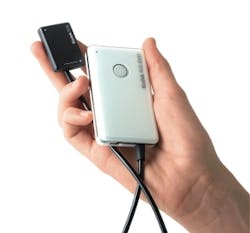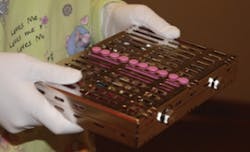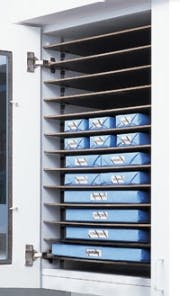Traveling the instrument-processing pathway: first class or coach?
By John A. Molinari, PhD, and Marie T. Fluent, DDS
The prime goal of the instrument-processing pathway is to deliver sterile instruments for patient care. This pathway is a complex, continuous, and cyclical journey that dental instruments take on a daily basis (Fig. 1). Although the destination of providing sterile instruments for patient care remains the same, clinicians may choose to have their instruments travel in “first class” (via sterilization cassettes), or “coach” (loose instruments in pouches).
At first, this choice may seem trivial, yet the decision is more than luxury-based. Cassette usage promotes improved infection control, efficiency, convenience, organization, and most importantly, a safer work environment for all those involved in sterilization procedures. Like any first-class journey, preplanning is required and an initial investment exists. In the long run, however, the benefits clearly outweigh the costs and the return on investment is quickly recuperated. Hours of time, production, and frustration will be saved in the process, and the longevity of dental instruments will be enhanced.
Prior to embarking upon any journey, choices in luggage must be made. High-quality luggage and cassettes are durable, easily identified, easy to handle, and last for many years. In addition, the electropolished finish of cassettes helps prevent corrosion. Functionality, convenient size, and ease of storage are also desirable qualities, along with perforations that allow for efficient cleaning while maintaining their ability to prevent sharps injuries. Instrument rails, holders, and racks secure instruments in place. These are often made of soft, flexible material that is color-coded for easy identification of a specific dental procedure or practitioner. The durability and security of the closing mechanism and locking knob or latch are of great importance to ease of use and maintaining instrument safety as they follow the processing pathway.
Use of acceptable containers to transport contaminated instruments safely to the sterilization area ensure that the working ends of instruments are not exposed, thereby preventing sharps injuries. Cassettes are specifically designed for this purpose, with instruments held securely and sharp tips contained within (Fig. 2).
Fig. 2 — Contaminated instruments in a cassette to be cleaned and sterilized. This practice can greatly reduce the possibility of personnel having a sharps accident.
Precleaning is an optional step in the instrument processing cycle. Perforated cassettes allow for easy presoaking and cleaning, while at the same time minimizing handling of individual contaminated instruments.
As instruments are processed and sterilized for reuse, they should be handled as little as possible to prevent sharps accidents. Manual cleaning is still allowed, though discouraged from a safety perspective and is far less efficient than mechanical cleaning. The use of ultrasonic cleaners or instrument washers improve cleaning effectiveness and decrease exposure to blood and other potentially infectious material. Therefore, cleaning with instruments in cassettes using automated equipment provides safer, more efficient processing than manual cleaning. In addition, cassettes hold instruments securely in place, which decreases the need to replace instruments that may become scratched, damaged, or lost during processing.
Cassettes can be easily rinsed and dried before wrapping without any direct handling of the instruments. The overall effect of using cassettes in combination with automated cleaning equipment is that a practice can use a “no-touch” instrument handling system that is safer and more efficient for clinical personnel. In addition, there is no need to sort instruments prior to processing since they have already been organized in theFig. 3 — Sterilized, wrapped instruments in cassettes stored in cabinets.
Cleaned instruments must be wrapped to prepare for heat sterilization. Packaging materials must be FDA-approved, compatible and applicable for the type of sterilization process used. A variety of packaging materials, such as bags, wraps, and pouches are available. Wrapped cassettes also may be labeled for easy identification using labels, color-coded tapes, or markers.
Whether instruments are processed using “first class” or “coach” approaches, all heat sterilization should be performed with the use of FDA-cleared medical equipment and used according to the manufacturer’s instructions. Correct loading of the sterilizer chamber is also essential. A common problem seen in dental facilities is overloading sterilizers with many more instrument pouches than recommended by manufacturers.
The purpose of storage is to maintain sterility until package integrity is broken at the time of use. Instrument pouches can easily be perforated during handling, and storage. Cassette usage can alleviate this potential problem (Fig. 3). In addition, cassettes keep the staff chairside during a procedure instead of searching for missing instruments.
The instrument processing and recirculation pathway involves multiple steps. Correct cleaning, packaging, sterilizer loading procedures, and storage practices are essential to ensure that an instrument is adequately processed and safe for reuse on patients. When traveling “first class” with instrument cassettes, the luxuries include not only increased organization and efficiency, but also time and cost savings and improved safety and infection control procedures for all clinical personnel.
Marie T. Fluent, DDS, is in private practice in the greater Ann Arbor community. She is an adjunct clinical lecturer for the University of Michigan, and a faculty member and a clinical instructor in the dental assisting program at Washtenaw Community College. Dr. Fluent is an assistant editor for THE DENTAL ADVISOR, and lectures and presents hands-on workshops on the topics of dental materials and infection control in the dental office.
John A. Molinari, PhD, is currently director of infection control for THE DENTAL ADVISOR in Ann Arbor, Mich. He is also coauthor of the text “Cottone’s Practical Infection Control in Dentistry,” with the third edition published in 2009. Dr. Molinari continues to serve as a consultant for the CDC, ADA Council on Scientific Affairs, Council on Dental Practice, and hospitals in the Detroit area in the areas of infectious disease and infection control.
Past DE Issues



